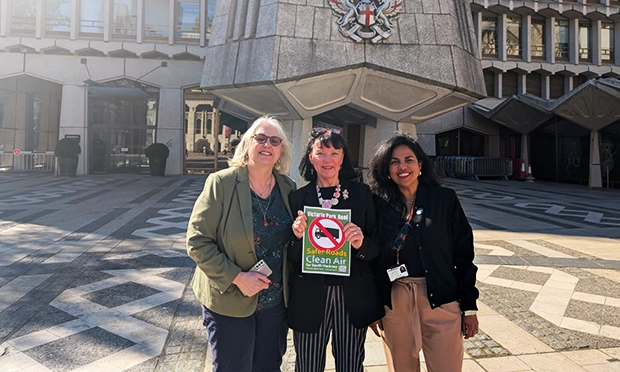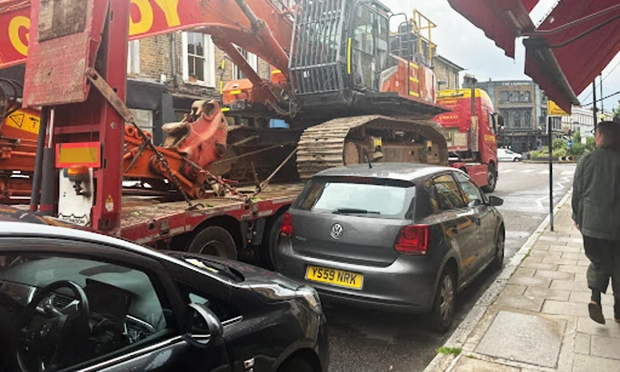Locals restart campaign to ban ‘intimidating’ HGVs from Victoria Park Road

Penny Wrout, Christine Jackson and Claudia Turbet-Delof. Photograph: courtesy of Penny Wrout. Free to use by partners of Local Democracy Reporting Service
Hackney locals have renewed their campaign to ban heavy goods vehicles (HGVs) from one of the borough’s A-roads, where “intimidating” lorry congestion is causing “mayhem”.
Resident Christine Jackson last week gave a presentation to the London Road Safety Council in Guildhall, seeking their help in persuading Transport for London (TfL) to prohibit HGVs on Victoria Park Road during certain hours.
She said an outright ban on the vehicles would “drastically” reduce the number of lorries using the road, helping to address the disproportionate number of deaths they cause and making the road “much safer”.
Speaking to the Citizen, Ms Jackson said: “The junction is completely gridlocked in the mornings, again at lunchtime and again in the evening, when the junction’s formal crossings are just impossible to use.”
She added that patients, visitors and staff at St Joseph’s Hospice and care home residents at Catherine House habitually use these crossings, near to where Victoria Park Road meets Mare Street.
Referring to the latter, she said: “Some have mobility problems, some are wheelchair users. How can they possibly cross the road safely?”
Joined by Victoria ward councillor Penny Wrout (Independent Socialist), she pointed to evidence of the gridlocked congestion zones – one dubbed ‘Night-Mare street’.

Victoria Park Road gridlock. Photograph: Christine Jackson
Other photos showed cycle hangars destroyed by HGVs and large vehicles “straddling” road crossings, while the presentation also highlighted lorry-related casualties in the area over the last 12 months.
“Over 50 per cent of fatalities involve HGVs, despite comprising less than 20 per cent of all freight mileage in London,” they said.
Cllr Wrout and Ms Jackson argued that piloting such a ban would support the Mayor of London’s freight transport action plan, which has the stated aim of curtailing the number of lorries and vans entering central London during morning hours (7am to 10am) by 10 per cent by next year.
The campaigners also drew on a recent Hackney Council-commissioned survey which found that, if these restrictions were in place, vehicles travelling northbound were more likely to exit the A12 earlier and use Bow Road’s dual carriageway instead.
Cllr Wrout told the Citizen the charity’s leaders were “very positive” about the presentation, but were unable to act as a lobbying force and instead offered some “excellent ideas for other ways to take the campaign forward”.
“It seems to us a cheap and easy way to enforce the Mayor’s strategy,” she said.
“We’re hoping now to meet with Hackney Council officers and cabinet members to feed back and engage them in lobbying TfL with us for a trial ban.”
The campaign for a HGV restriction was previously brought to Hackney Council’s cabinet by Ms Jackson and other activists, when the borough’s former climate chief Mete Coban said he “really wanted” to work with them on the issue and called for further investigation.
He cautioned that it would not “normally be appropriate” to apply a weight limit to an A-road like Victoria Park Road.

Penny Wrout, Christine Jackson and Claudia Turbet-Delof
At the time, a resident in nearby Tower Hamlets told the Citizen they felt it was a “NIMBY effort to push unwanted traffic away from an affluent area in Hackney down to Tower Hamlets”.
To this, Jackson said: “I am time-poor too, but consider the safety of residents and users of Victoria Park Road to be paramount and so have to find time.”
She added that since the deputation she had only seen “tinkering” from the council, despite her having met with Streetscene and Hackney’s climate and transport chief, Cllr Sarah Young, on Victoria Park Road during their inspection.
“In reality the whole junction needs re-designing, but we know the council are strapped for cash.
“So a quick, cheap win would be to ban HGVs from the road. They make up around 16 per cent of traffic on the road but take up an awful lot of space, and are intimidating when they straddle the crossings.”
